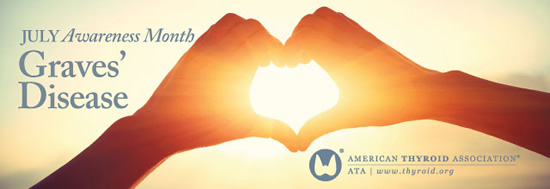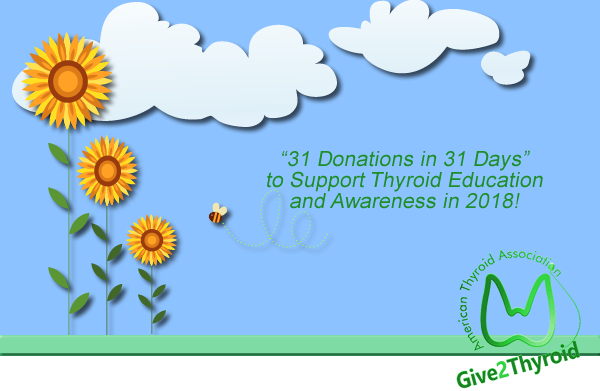Clinical Thyroidology for the Public summarizes selected research studies discussed in the previous month’s issue of Clinical Thyroidology, an official publication of the American Thyroid Association. Editor-in-chief, Alan Farwell, MD, FACE
Volume 11 Issue 7
Available in pdf format for saving and printing and Web page format for viewing online
PDF Format for Saving and Printing
Clinical Thyroidology for the Public Volume 11 Issue 7 (PDF file, 5.68 MB)
TABLE OF CONTENTS – Web Format
GRAVES’ DISEASE Addition of selenium to methimazole does not alter the response to therapy in Graves’ hyperthyroidism
The essential trace element selenium is necessary for the normal production and action of thyroid hormone. There is evidence that selenium may also be involved in affecting processes related to thyroid autoimmunity which causes both hypothyroidism and hyperthyroidism. The aim of this study was to determine whether selenium supplementation given to patients with Graves’ disease who were starting treatment with methimazole resulted in improved response or remission rates.
Kahaly GJ et al. Double-blind, placebo-controlled, randomized trial of selenium in Graves hyperthyroidism. J Clin Endocrinol Metab 2017;102:4333-41.
(PDF File for saving and printing, 785 KB)
THYROID AND PREGNANCY Endocrine disrupting chemicals during pregnancy and thyroid function in the mother and the baby
Normal thyroid function is very important for normal brain development of the baby. Endocrine disrupting chemicals (EDC’s) are chemicals in the environment that have been shown to affect hormonal systems in humans and animals. A growing body of literature has linked EDC exposure to alterations in thyroid function. This study measured six different EDCs in the blood of both mother and baby and compared levels with measurements of thyroid function.
Preston EV et. 2018 Maternal plasma per- and polyfluoroalkyl substance concentrations in early pregnancy and maternal and neonatal thyroid function in a prospective birth cohort: Project Viva (USA). Environ Health Perspect 126:027013. PMID: 29488882.
(PDF File for saving and printing, 656 KB)
THYROID CANCER Rate of nodule growth on surveillance ultrasound predicts risk of cancer
Thyroid nodules that have benign biopsy results still need to be followed by ultrasound surveillance and nodules that significantly grow need to undergo a 2nd biopsy to ensure the initial biopsy did not miss a cancer. However, nodule growth alone is not very specific to identify a cancer as low-risk thyroid cancers may remain stable for several years. To help sort this out, the current study compared the rate of nodule growth between nodules with benign and cancerous cytology during ultrasound surveillance.
Angell TE et al. Differential growth rates of benign versus malignant thyroid nodules. J Clin Endocrinol Metab. October 12, 2017.
(PDF File for saving and printing, 614 KB)
THYROID CANCER Higher TSH level is associated with papillary microcarcinoma growth during active surveillance
While surgery is usually recommended when thyroid cancer is diagnosed, if the nodule/cancer is <1 cm another option is observation, otherwise known as active surveillance. TSH is a growth factor that stimulates thyroid tissue to produce thyroid hormone; also it affects the growth of thyroid cells and thyroid cancer cells. This study describes the association between serum TSH level and growth of PTMC.
Kim HI et al. High Serum TSH Level Is Associated With Progression of Papillary Thyroid Microcarcinoma During Active Surveillance. J Clin Endocrinol Metab. 2018 Feb 1;103(2):446-451. doi: 10.1210.
(PDF File for saving and printing, 663 KB)
THYROID NODULES Management of thyroid nodules in patients over the age of 70 needs to consider coexistent serious diseases
Thyroid nodules are found in up to 50% of the population over the age of 60. Data on older patients with thyroid nodules are limited, and management should not only be guided by risk of cancer of these nodules, but also by the risks of any intervention. The goal of this study was to present detailed information on the evaluation, treatment and outcome of patients with thyroid nodules who are 70 years Wang Z et al. 2018 Quantitative analysis of the benefits and risk of thyroid nodule evaluation in patients ≥70 years old. Thyroid 28:4764–471. Epub 2018 Apr 2. PMID: 29608439.
(PDF File for saving and printing, 734 KB)
THYROID CANCER Minimal extrathyroidal extension leads to a slight increase in thyroid cancer recurrence, but does not impact survival for thyroid cancer
It is controversial whether minimal extrathyroidal extension (ETE) impacts thyroid cancer recurrence or death. The AJCC thyroid cancer staging took minimal ETE out of staging for survival, but currently it is still part of the ATA guidelines risk of recurrence model that was last updated in 2015. This study wanted to re-examine the role of minimal ETE on recurrence and survival for thyroid cancer.
Diker-Cohen T et al, 2018 Impact of minimal extra-thyroid extension in differentiated thyroid cancer: systematic review and meta-analysis. J Clin Endocrinol Metab. Epub 2018 Mar 1. PMID: 29506045.
(PDF File for saving and printing, 620 KB)





